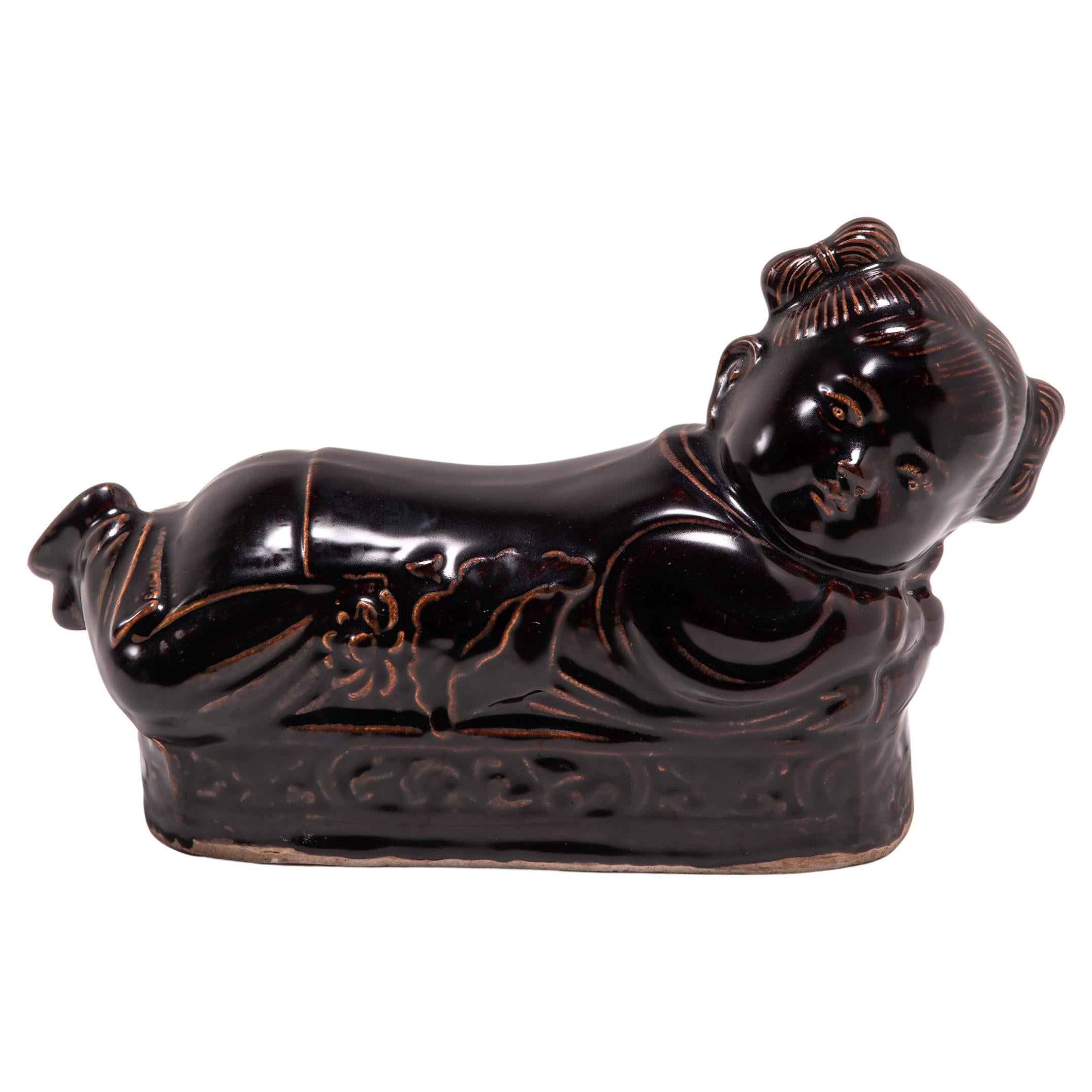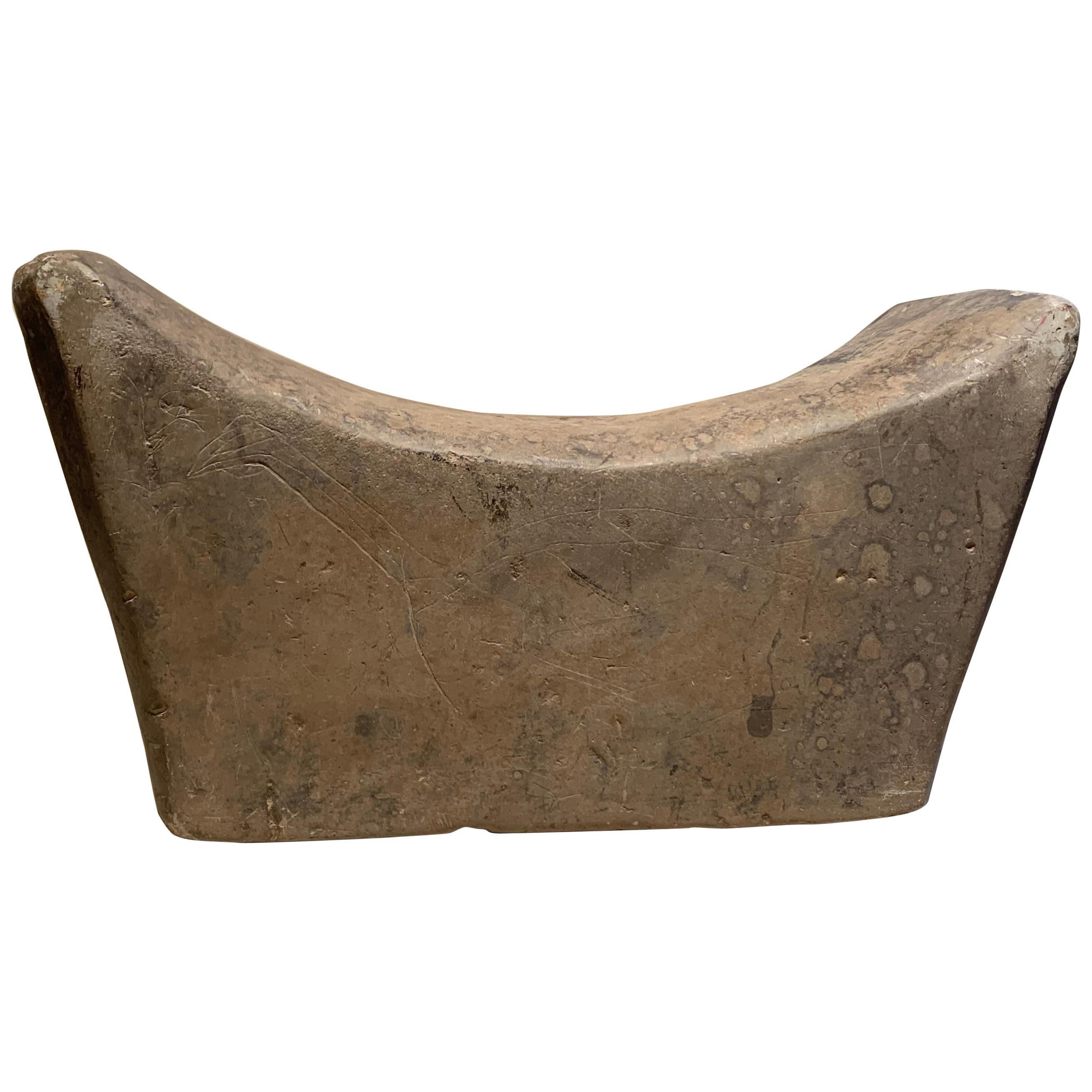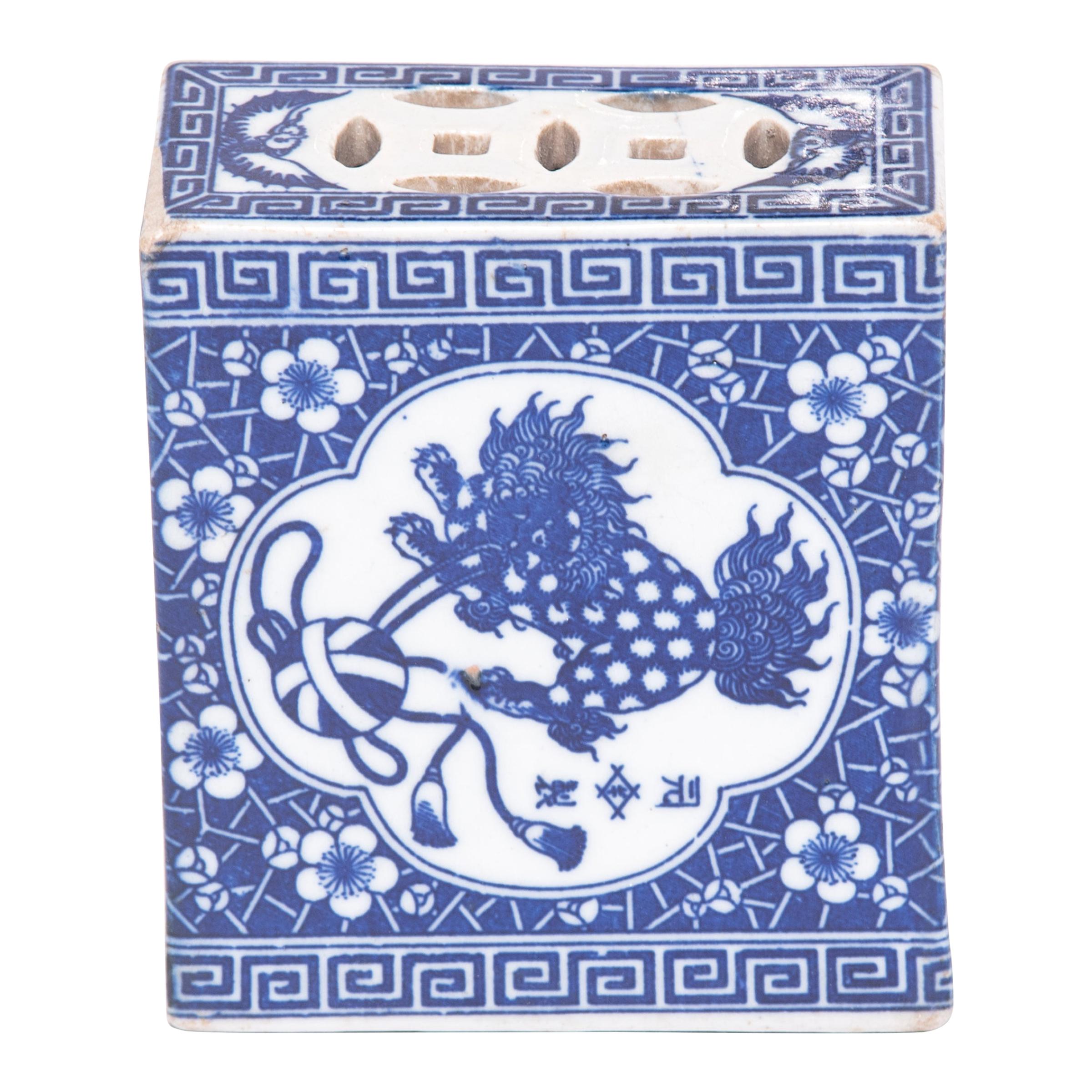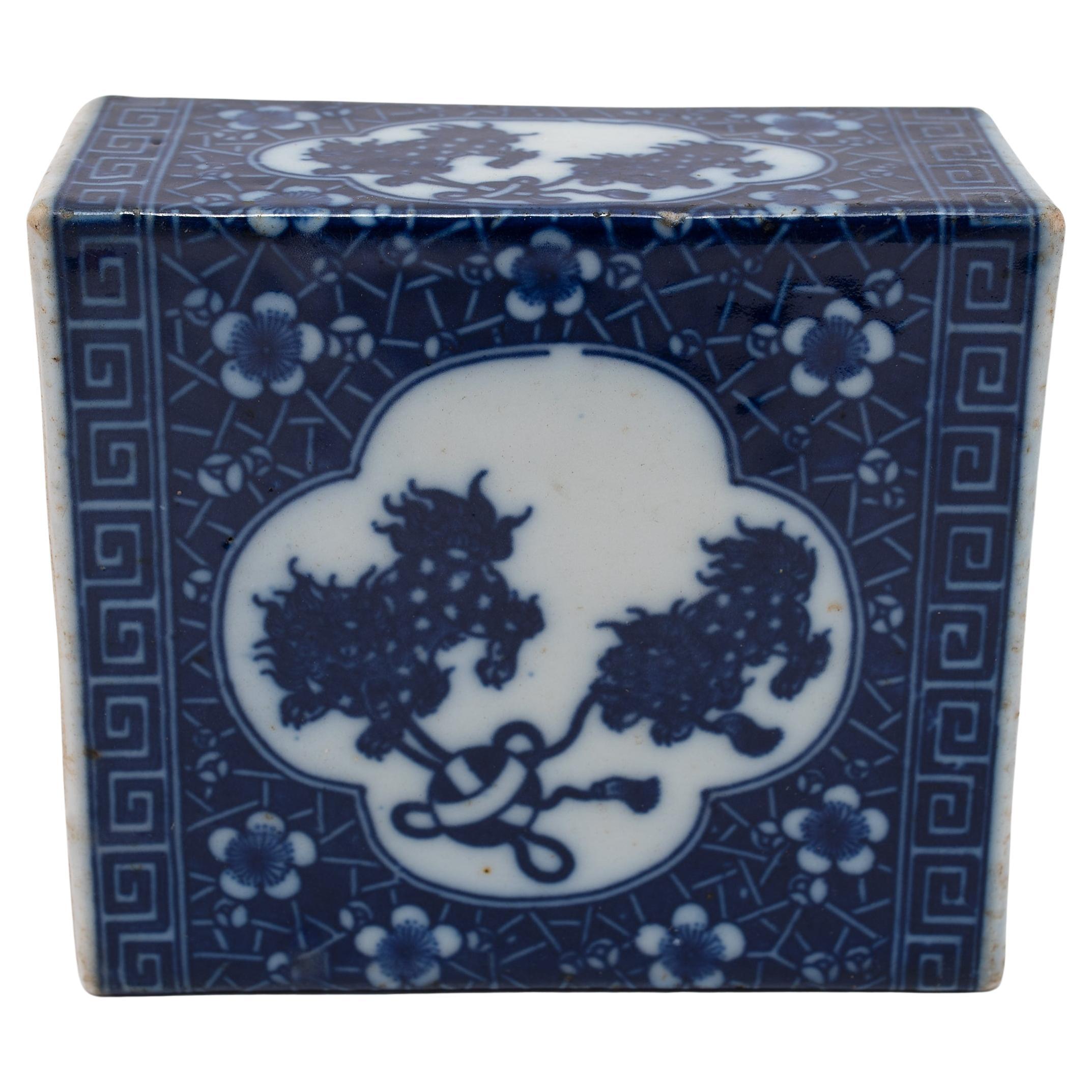Items Similar to Chinese Celadon Glazed Temple Headrest, c. 1900
Want more images or videos?
Request additional images or videos from the seller
1 of 6
Chinese Celadon Glazed Temple Headrest, c. 1900
About the Item
To keep her elaborate hairstyle intact while sleeping, a well-to-do Qing-dynasty woman would use a rigid headrest or neck pillow to keep her head elevated. Whether functional or purely decorative, such headrests were crafted from a variety of materials and were often decorated with elaborate patterns or symbolic motifs.
This ceramic headrest dates to the turn of the century and is modeled in the form of a temple or other grand building. Likely intended as a decorative sculpture, the headrest is charmingly detailed, with perforated lattice windows, low outer railings, and a curved top textured to resemble roof tiles. Peering through the arched doorway, you can make out a group of robed figures performing a ceremony before a raised altar. A pale blue-green celadon glaze cloaks the exterior with a glassy finish.
- Dimensions:Height: 4.25 in (10.8 cm)Width: 8.25 in (20.96 cm)Depth: 4.75 in (12.07 cm)
- Style:Qing (In the Style Of)
- Materials and Techniques:Porcelain,Glazed
- Place of Origin:
- Period:
- Date of Manufacture:circa 1900
- Condition:Wear consistent with age and use. Minor losses. Minor chips and losses.
- Seller Location:Chicago, IL
- Reference Number:

About the Seller
4.9
PAGODA RED is a renowned resource for designers as well as collectors of contemporary and ancient Chinese, Korean and Japanese art. They offer a curated edit of fine and provincial furniture, ceramics, scholars' objects, and paintings and textiles, each piece historically and geographically authentic.
Diamond Seller
These expertly vetted sellers are 1stDibs' most experienced sellers and are rated highest by our customers.
Established in 1997
1stDibs seller since 2006
1,416 sales on 1stDibs
Typical response time: 1 hour
- ShippingRetrieving quote...Ships From: Chicago, IL
- Return PolicyA return for this item may be initiated within 2 days of delivery.
More From This SellerView All
- Chinese Lucky Girl Headrest, c. 1900Located in Chicago, ILTo keep her elaborate hairstyle intact while sleeping, a well-to-do Qing-dynasty woman would use a rigid headrest or neck pillow to keep her head elevated. Whether functional or purely decorative, such headrests were crafted from a variety of materials and were often decorated with elaborate patterns or symbolic motifs. This porcelain headrest...Category
Early 20th Century Chinese Qing Ceramics
MaterialsPorcelain
- Chinese Ceramic Spotted Cat Headrest, c. 1900Located in Chicago, ILTo keep her elaborate hairstyle intact while sleeping, a well-to-do Qing-dynasty woman once used this ceramic headrest as a pillow. The headrest is shaped as a crouching house cat, w...Category
Early 20th Century Chinese Qing Ceramics
MaterialsCeramic
- Chinese Ho Ho Boy Headrest, c. 1900Located in Chicago, ILTo keep her elaborate hairstyle intact while sleeping, a well-to-do Qing-dynasty woman once used this ceramic headrest as a pillow. This headrest is shaped in the form of a baby boy,...Category
Early 20th Century Chinese Qing Ceramics
MaterialsCeramic
- Chinese Sancai Peony Headrest, c. 1900Located in Chicago, ILTo keep her elaborate hairstyle intact while sleeping, a well-to-do Qing-dynasty woman once used this ceramic headrest as a pillow. Its unusual form is densely patterned with abstrac...Category
Antique Late 19th Century Chinese Qing Ceramics
MaterialsCeramic
- Chinese Blue and White Headrest with Guardian Lion, c. 1850Located in Chicago, ILIn order to keep her elaborate hairstyle intact while sleeping, a well-to-do Qing-dynasty woman once used this ceramic box as a pillow. Lavishly decorated in the traditional blue-and...Category
Antique Mid-19th Century Chinese Qing Ceramics
MaterialsPorcelain
- Chinese Blue and White Fu Lion HeadrestLocated in Chicago, ILThis small ceramic block is actually a form of Chinese headrest or neck pillow. Popular during the Qing dynasty, rigid headrests such as this were used by upper-class women to protect their elaborate hairstyles by elevating the head during slumber. This example dates to the mid-20th century and is glazed in the blue-and-white style with dark, cobalt-blue color. Each side of the headrest has a quadrilobe cartouche framing two mythical fu lions playing with a brocade ball, a motif that evokes the idiom "may you and your descendant achieve high rank." A powerful and benevolent guardian, the fu lion (shizi) is the perfect force to protect against nightmares and bad energy. The playful scene is surrounded by a cracked ice pattern dotted with plum blossoms, symbols of winter and longevity. A geometric meander trims the corners and small bats frame coin...Category
Mid-20th Century Chinese Chinese Export Ceramics
MaterialsPorcelain
You May Also Like
- Chinese Ceramic HeadrestLocated in Vosselaar, BEA Chinese unglazed ceramic headrest with lovely patina and naieve carvings on both sides. ONe geometrical and one of a fantasy beast (griffion?). These headrests are found in difform...Category
Antique Early 19th Century Chinese Ceramics
MaterialsCeramic
- Celadon Crakle Glaze Chinese VaseLocated in Alessandria, PiemonteSimple modern taste for this vintage crakle Chinese vase, also suitable for a table lamp. (from my Chinese Collection). nr. O/3202. (special price for closing activities).Category
Early 20th Century Chinese Archaistic Ceramics
MaterialsCeramic
- Chinese Green Glazed Jar / Planter, c. 1900Located in Jimbaran, BaliA wonderful blue-green glaze adorns this early 20th Century Chinese storage jar along with a stunning crackled finish. Jars such as these would be used to store grains amid people's ...Category
Early 20th Century Chinese Qing Ceramics
MaterialsCeramic
- Small Chinese Celadon Glazed Porcelain Kendi, Qing Dynasty, 18th Century, ChinaLocated in Austin, TXA darling small Chinese celadon glazed kendi, or pouring vessel, mid Qing Dynasty, 18th century, China, for the Southeast Asian market. The diminutive kendi of typical form, with ...Category
Antique 18th Century Chinese Qing Ceramics
MaterialsPorcelain
- Pair Chinese Shar Pei Puppies Hand Painted Sancai Glaze, circa 1860Located in Katonah, NYThis pair of small Chinese Shar Pei puppies was made in the mid-19th century, circa 1860. They are charming creatures with adorable faces. Th...Category
Antique Mid-19th Century Chinese Qing Animal Sculptures
MaterialsStoneware
- Chinese Foo Dog Hardwood Hand Carved and Signed, Qing circa 1900Located in Lincoln, LincolnshireThis is a good Chinese hardwood foo dog, sometimes called a temple lion that we date to the late Qing period, circa 1900. The piece is hand carved as a fierce dog or lion sat on a...Category
Early 20th Century Chinese Qing Ceramics
MaterialsHardwood





